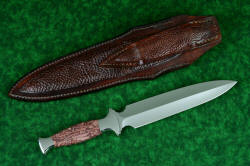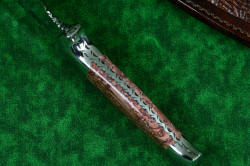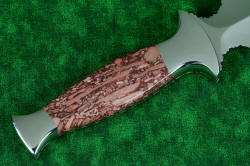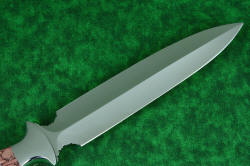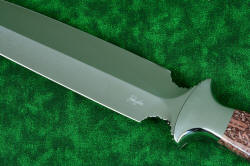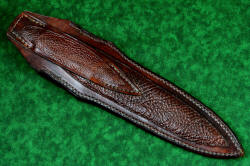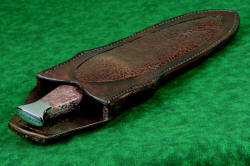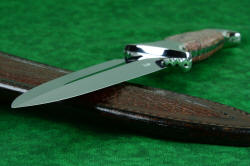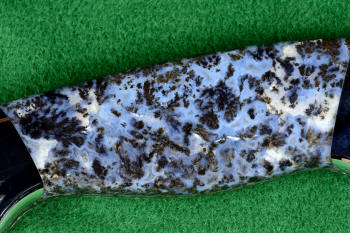"Streamspear" Dagger
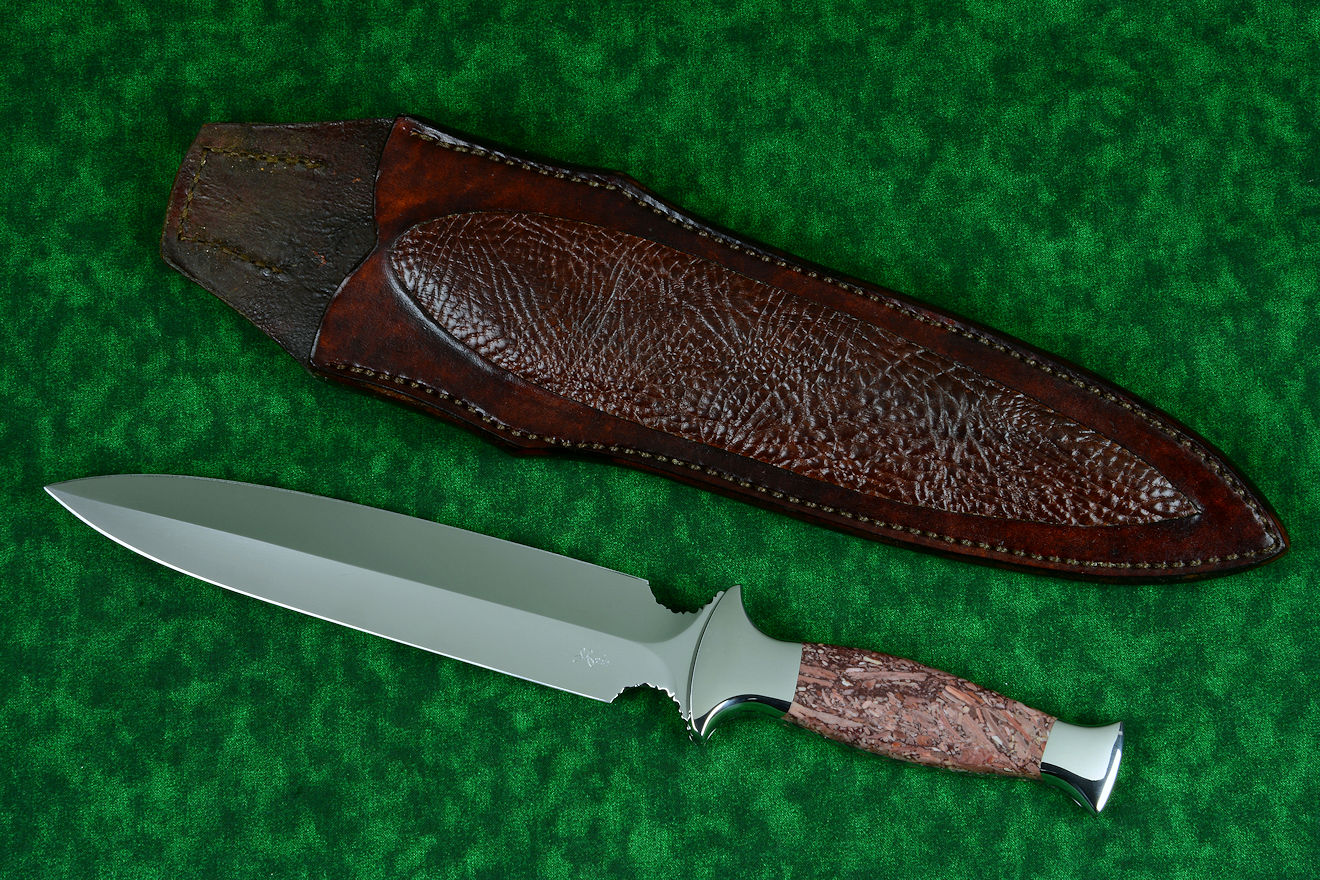
"Streamspear" Fine Handmade Dagger
- Size: Length overall:12.5" (31.8 cm), Blade Length: 7.6" (19.3 cm), Thickness: .227" (5.8 mm)
- Weight: Knife: 12.3 oz. (349 grams) Sheath: 7.9 oz. (224 grams)
- Blade: ATS-34 High Molybdenum Stainless Steel, Hardened and Tempered to Rockwell HRC 58.5, Mirror Polished
- Bolsters, Fittings: 304 Austenitic Stainless Steel, Mirror polished
- Handle: Fossilized Stream Bed Dolomite (Montana
Bark Jasper) Gemstone
- Sheath: Hand-carved Leather Shoulder inlaid with Bison (American Buffalo) skin
- Knife: Smooth and straight, a long
full-tang dagger often reminds me of thin, fast, and sleek
movements like a fish spearing through a mountain stream or
river. Inspired
by the gemstone handle material, (below) this "Streamspear" dagger
exhibits fine lines and elegant geometric form of the spear-bladed
knife.
- The steel I chose for this dagger is ATS-34, a highly tough
and durable hypereutectoid alloy, the same steel I've used in
many counterterrorism and tactical combat knives. Because ATS-34
is high in molybdenum, its very tough, and a thin point can be
much more resistant to fracture than in lower-molybdenum tool
steels. Tempering the steel to 58.5 toughens the steel even
more. I've mirror-polished this beautiful stainless steel for
beauty, longevity, and high corrosion resistance.
- The dagger geometry seems straightforward, but there are all
different types of daggers. This particular design is a "spear"
point; the blade is straight, with a center apex and spine, and
is symmetrical like a spear of old. It is a difficult geometry
to get just right, with matching grinds, terminations and
alignment all accomplished offhand. Also, the grinds are hollow,
for a thin, serviceable cutting edge and a thick, strong spine.
The tang is tapered for balance, and fully fileworked in
a vine pattern for handmade distinction. Even the choils are
fileworked in a graduated vine pattern right to the cutting
edge. The blade is long and elegant, yet surprisingly
lightweight for its size.
- I bolstered the knife with zero-care 304 high chromium, high
nickel stainless steel bolsters, which are contoured, rounded and
finished for a comfortable feel. The bolsters are secured with
zero-clearance peened pins and dovetailed to bed the scales.
The bolsters are slightly angled to fully lock in the scales and
give an informal line to the handles.
- The handle scales are a center of focus on this dagger; just
right for the design. The gemstone is called Montana Bark
Jasper, but this is actually a misnomer! This shows how
casually the lapidary trade is with names of materials, but
sometimes the casual name sticks. Perhaps the only correct part
of the name is the origin, the big western state of Montana. The
material is neither bark or jasper! It's actually fossilized
stream bed, and the stone is dolomite. It's
fascinating to think that millions of years ago, a stream ran
and churned and deposited, sand, leaves, bits of wood, living
things, and debris along its bottom. Perhaps some cataclysmic
event covered over the stream bed, and fossilization began. In
millions of years, the original materials and the mud were
replaced by minerals seeping in and the deposits would become
dolomite (technically "sedimentary dolostone"). This particular
dolomite is a tough and durable stone, and is used in fine
jewelry and cabochons. The neat thing is what you can see and
touch in the large pieces available in a knife handle scale.
Shapes and forms ranging from sand grains to bits of leaves and
woody forms abound, bits of once-living things that came to rest
on the bottom of a very, very ancient and long-gone stream
or river. This
is one of the reasons I love working with gemstone and fossils.
The gemstone scales are locked under the bolster dovetails,
bedded to the full tang of the blade, and contoured and finished
to a warm luster.
- The shape of the handle is a lightweight, elegant hourglass
form, with wide forward quillons to stop the hand from sliding
forward, and a narrow "fishtail" butt at the rear bolster that
adds to the Streamspear's form. The balance point of
the dagger is at the quillons, and the Streamspear feels large,
yet surprisingly lightweight in the hand.
- Sheath: A long, deep, and classy sheath was
necessary for this dagger, one that reflected the location of the
ancient streambed, so I inlaid Bison (American Buffalo) skin in
hand-carved 9-10 oz. leather shoulder. The technically correct name
for this skin is Bison, since it's easy to confuse what we
call American Buffalo with Cape Buffalo and Water Buffalo, entirely
different animals. The bison skin is tough, beautiful, and with a great
texture. I shaped full-panel inlays to compliment the design on
the front, back, and even in the belt loop of the sheath. The sheath
is deep with a high back, allowing a low position on the belt, and
protection of and from the razor-keen spear-point blade edges. The
sheath is dyed a medium brown, stitched with heavy nylon and
lacquered and sealed.
- A classy North American dagger style in clean, smooth form and execution.
Hi Jay,
Streamspear arrived today and I am very happy with it! This is a classic as well as a very
classy knife. The class starts even with unwrapping it. The leather sheath itself is beautiful
and in the fabric bag makes you feel like you have something really special in your hands. I
think that only a knife lover can appreciate the true beauty of a knife like this and appreciate
the craftsmanship and skill that has gone into making it. I have to say again the knife is
beautiful! The spear point is a very clean design and all aspects of it are perfectly symmetrical.
The double edge is perfect as well, and is easily the sharpest knife I own. The filework really
gives it the extra class. The balance is excellent and even though it is a longer blade it is
still easy to hold. The dolomite handle is beautiful in itself and adds to the overall appearance
and class to the knife. And when you said it had a mirror polish, you were not kidding!
All in all, a great knife and something that will be the centerpiece of my collection. I will be watching
for more knives for sale on your website.
Thank you Jay,
--J.
Please click on thumbnail knife photos
